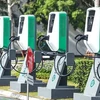Hanoi (VNA) – E-commerce and online shopping are forecast to become a key trend in the world, accounting for 25 percent of the global retail revenue, experts said, suggesting Vietnam promptly complete infrastructure system to boost the growth of trade.
According to the Vietnam E-Commerce and Digital Economy Agency under the Ministry of Industry and Trade, a person spends an average of nearly 25 hours online every week, or over 3 hours per day.
At the same time, nearly one third of Internet users conduct online shopping with expenditure of about 160 USD per person each year.
It is estimated that in 2020, as many as 30 percent of the Vietnamese population will involve in online shopping with spending of 350 USD each per year.
The most popular goods of online deals are garments, footwear (64 percent); books, music, stationeries (51 percent); cosmetics and personal caring products (40 percent), information technology and house appliances (40 percent), furniture (29 percent); and foods (20 percent).
Many big retailers such as Lotte Vietnam and Aeon Vietnam have stepped up their online trading channels to compete with popular names such as Adayroi, Alibaba, The gioi di dong, Lazada, Vat gia and En bac.
Nguyen Huu Tuan, head of the E-Commerce Management Office under the Vietnam E-Commerce and Digital Economy Agency, said that e-commerce has seen strong growth, which is suitable to the development of the modern economy thanks to its strength in convenience, especially for busy people. About half of the Vietnamese population have accessed the Internet, and Vietnam is now one of the leading countries in people’s spending time online, he said.
Currently, a Vietnamese owns 1.3 cell phones averagely, 70 percent of which are smartphones, he noted, adding that a firm infrastructure is a foundation for e-commerce sector of Vietnam to earn 4 billion USD last year.
Dang Hoang Hai, Director of the Vietnam E-Commerce and Digital Economy Agency, said that over the past years, online distribution channels have grown diversely with major forms of websites, online trading floors, social networks on both web and online base.
Therefore, about 46 percent of enterprises have built and operated their own websites, while 13 percent of them have joined online trading floors, he noted.
In the 2012-2016 period, the ratio of firms receiving orders and making orders through websites grew 30 percent. Notably, as many as 76 percent of the websites have national coverage, while 24 percent covers localities or regions.
Meanwhile, the development of online payment methods has also effectively supported e-commerce.
However, Hai admitted that infrastructure supporting e-commerce such as e-receipts, e-payment and logistics have developed at different levels without synchronization and connections. This is also a reason why 40 percent of customers complained about stagnation in e-commerce.
Vu Hoang Lien, President of the Vietnam Internet Association, stressed that retailers should focus more on marketing and online sale, while enhancing the quality of delivery services as well as the online payment in their websites and keeping a close watch on new e-commerce trends to ensure their competitiveness.
Lien also pointed to the need to build reputation and prestige of trademarks to improve competitiveness, initially through the choosing of a good domain name.
Experts also highlighted the need to rapidly and comprehensively expand the infrastructure serving e-commerce, as well as the settlement of shortcomings in packing, designs, quality and logistics.
They stressed the need for reinforcement of e-commerce safety and security as well as the formation of management and supervising system over online trading activities.
Hai revealed that the Ministry of Industry and Trade has coordinated with relevant agencies to launch the Keypay e-payment system with suitable features for Vietnamese businesses.
The ministry has also concentrated on building a system for managing e-receipts that is widely applicable in the market as well as solutions for e-receipt matters, thus creating a firm foundation for the growth of e-commerce in the future, added Hai.-VNA
According to the Vietnam E-Commerce and Digital Economy Agency under the Ministry of Industry and Trade, a person spends an average of nearly 25 hours online every week, or over 3 hours per day.
At the same time, nearly one third of Internet users conduct online shopping with expenditure of about 160 USD per person each year.
It is estimated that in 2020, as many as 30 percent of the Vietnamese population will involve in online shopping with spending of 350 USD each per year.
The most popular goods of online deals are garments, footwear (64 percent); books, music, stationeries (51 percent); cosmetics and personal caring products (40 percent), information technology and house appliances (40 percent), furniture (29 percent); and foods (20 percent).
Many big retailers such as Lotte Vietnam and Aeon Vietnam have stepped up their online trading channels to compete with popular names such as Adayroi, Alibaba, The gioi di dong, Lazada, Vat gia and En bac.
Nguyen Huu Tuan, head of the E-Commerce Management Office under the Vietnam E-Commerce and Digital Economy Agency, said that e-commerce has seen strong growth, which is suitable to the development of the modern economy thanks to its strength in convenience, especially for busy people. About half of the Vietnamese population have accessed the Internet, and Vietnam is now one of the leading countries in people’s spending time online, he said.
Currently, a Vietnamese owns 1.3 cell phones averagely, 70 percent of which are smartphones, he noted, adding that a firm infrastructure is a foundation for e-commerce sector of Vietnam to earn 4 billion USD last year.
Dang Hoang Hai, Director of the Vietnam E-Commerce and Digital Economy Agency, said that over the past years, online distribution channels have grown diversely with major forms of websites, online trading floors, social networks on both web and online base.
Therefore, about 46 percent of enterprises have built and operated their own websites, while 13 percent of them have joined online trading floors, he noted.
In the 2012-2016 period, the ratio of firms receiving orders and making orders through websites grew 30 percent. Notably, as many as 76 percent of the websites have national coverage, while 24 percent covers localities or regions.
Meanwhile, the development of online payment methods has also effectively supported e-commerce.
However, Hai admitted that infrastructure supporting e-commerce such as e-receipts, e-payment and logistics have developed at different levels without synchronization and connections. This is also a reason why 40 percent of customers complained about stagnation in e-commerce.
Vu Hoang Lien, President of the Vietnam Internet Association, stressed that retailers should focus more on marketing and online sale, while enhancing the quality of delivery services as well as the online payment in their websites and keeping a close watch on new e-commerce trends to ensure their competitiveness.
Lien also pointed to the need to build reputation and prestige of trademarks to improve competitiveness, initially through the choosing of a good domain name.
Experts also highlighted the need to rapidly and comprehensively expand the infrastructure serving e-commerce, as well as the settlement of shortcomings in packing, designs, quality and logistics.
They stressed the need for reinforcement of e-commerce safety and security as well as the formation of management and supervising system over online trading activities.
Hai revealed that the Ministry of Industry and Trade has coordinated with relevant agencies to launch the Keypay e-payment system with suitable features for Vietnamese businesses.
The ministry has also concentrated on building a system for managing e-receipts that is widely applicable in the market as well as solutions for e-receipt matters, thus creating a firm foundation for the growth of e-commerce in the future, added Hai.-VNA
VNA























